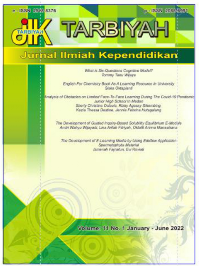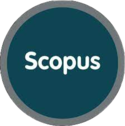The Development of Guided Inquiry-Based Solubility Equilibrium E-Module
DOI:
https://doi.org/10.18592/tarbiyah.v11i1.6466Abstract
Solubility equilibrium is a basic material of chemistry that involve an abstract concept. The visualization of abstract concept can be presented using the electronic media in the form of pictures, videos, and animations. The guided inquiry is one of the right strategies to teach about solubility equilibrium. The purpose of this research was to develop, determine the validity and the eligibility of the guided inquiry-based solubility equilibrium e-module. This research used Borg and Gall’s development model with 5 stages, which were the product analysis, the initial product development, the expert validation and revision, the field trial, the trial result analysis, and the product revision. The product validity has a very valid criteria in terms of the material, media, and language expert assessment with the average percentages were 96,11%, 83,18%, 90,61%. The students’ response to the product showed that the product was very proper to used in the learning based on the average percentage of 90,61%. That meant the developed guided inquiry-based solubility equilibrium e-module could be one of the teaching materials for basic chemistry course.References
Asmiyunda, A., Guspatni, G., & Azra, F. (2018). Pengembangan E-Modul Kesetimbangan Kimia Berbasis Pendekatan Saintifik untuk Kelas XI SMA/MA. Jurnal Eksakta Pendidikan (JEP), 2 (2): 155-161.
Blanchard, M.R., Shouterland, S.A., Osborne, J.W., Sampson, V.D. Anneta, L.A., & Granger, E.M. (2010). Is Inquiry Possible in Light of Accountability?: A Quantitative Comparison of The Relative Effectiveness of Guided Inquiry and Verification Laboratory Instruction. Science education, 578-616
Borg, W.R. & Gall, J.P. (2003). Educational Research: An Introduction. 7th Edition. Pearson.
Chandrasegaran, A.L., Treagust, D.F., & Mocerino, M. (2007). The Development of Two-Tier Multiple-Choice Diagnostic Instrument for Evaluating Secondary School Students’ Ability to Describe and Explain Chemical Reactions using Multiple Levels of Representation. Chemistry Education Research and Practice, 8 (3): 293-307.
Cheva, V. K., & Zainul. R. (2019). Pengembangan E-Modul Berbasis Inkuiri Terbimbing pada Materi Sifat Keperiodikan Unsur untuk SMA/MA Kelas X. EduKimia, 1 (1): 28-36.
Dahar, R.W. (2011). Teori-Teori Belajar & Pembelajaran. Jakarta : Erlangga.
Depdiknas. (2008). Panduan Pengembangan Bahan Ajar. Direktorat Jenderal Manajemen Pendidikan Dasar dan Menengah.
Eggen, P., & Kauchak, D. (2004). Educational Psychology: Windows on Classrooms, 6th Edition. Upper Saddle River: Pearson Education, Inc.
Furqan, H., Yusrizal, Y., & Saminan, S. (2016). Pengembangan Modul Praktikum Berbasis Inkuiri Untuk Meningkatkan Keterampilan Proses Sains Dan Hasil Belajar Siswa Kelas X Di SMA Negeri 1 Bukit Bener Meriah. Jurnal Pendidikan Sains Indonesia (Indonesian Journal of Science Education), 4 (2): 124–129.
Gilbert, J.K. (2005). Visualization in Science Education. Dordrecht: Springer.
Hanson, D.M. (2005). Designing Process-Oriented Guided-Inquiry Activities. In S. W. Bayerlein & D.K. Apple (Eds). IL: Pacific Crest.
Kasih, A.N.I.E., Sundaryono, A., & Nursa’adah, E. (2021). Development of Electronic Module Based on POE (Predict, Observation, Explanation) in Natural Organic Chemistry Learning. Edukimia (Jurnal Kimia dan Pendidikan), 6 (2): 231-242.
Kelly, R. M., Barrera, J.H., & Saheed. (2010). An Analysis of Undergraduate General Chemistry Students’ Misconceptions of Submicroscopic Level of Precipitation. Journal of Chemical Education, 87 (1): 113-118.
Madden, S. P., Jones, L. L., & Rahm, J. (2011). The Role of Multiple Representations in The Understanding of Ideal Gas Problems. Chemistry Education Research and Practice, 12 (3), 283-293.
Mayasari, E., Enawaty, E., & Erlina. (2012). Pengaruh Penggunaan Buku Ajar Ikatan Ionik dengan Pendekatan Multirepresentasi terhadap Prestasi Belajar Siswa. Jurnal Pendidikan Dan Pembelajaran, 66, 37-39.
Mitra, B., Lewin-Jones, J., Barrett, H., & Williamson, S. (2010). The use of video to enable deep learning. Research in Post-Compulsory Education, 15(4): 405-414.
Naseriazar, Ozmen, & Badrian. (2011). Effectiveness of Analogies on Students Understanding of Chemical Equlibrium. Western Anatolia Journal of Educational Sciences. 491-495.
Novianty, I., Sulistina, O., & Zakia, N. (2013). Efektivitas Penerapan Modul Materi Analisis Elektrokimia Berbasis Inkuiri Terbimbing terhadap Hasil Belajar dan Persepsi Siswa Kelas XI Semester 1 Kompetensi Keahlian Analisis Kimia SMKN 7 Malang. Journal of Chemical Information and Modeling, 53 (9): 1689–1699. https://doi.org/10.1017/CBO9781107415324.004.
Onder, I. & Geban, O. (2006). The Effect of Conceptual Change Texts Oriented Instruction On Students’ Understanding of the Solubility Equilibrium Concept. Journal Of Education, (30): 166-173.
Pratama, R., & Masykuri, M. (2018). The Effectiveness of Implementation of Virtual Based Guided-Inquiry Module on Thermochemistry Concept at One of State Senior High School in Selong. 5th ICRIEMS Proceedings Published by Faculty of Mathematics And natural Science, VII (Education), 71-76.
Purwanto., Rahadi, A., & Lasmono, S. (2007). Pengembangan Modul dalam Seri Teknologi Pembelajaran. Jakarta: Depdiknas.
Quilez, J. (2004). Changes in Concentration and in Partial Pressure in Chemical equlibria: Students’ and Teachers’ Misunderstandings. Chemistry Education: Research and Practice, 5 (3): 281-300.
Raviolo, A. & Garritz. (2008). Analogies in the Teaching of Chemical Equilibrium: A Synthesis/Analysis of the Literature. Chemistry Education: Research and Practice, 5 (3): 281-300.
Riduwan. (2013). Skala Pengukuran Variabel-Variabel Penelitian. Bandung: Alfabeta.
Schunk, D.H., Pintrich, P.R., & Meece, J.L. (2008). Motivation in Education: Theory, Research, and Application. Upper Saddle River: Pearson Education, Inc.
Sund, R.B. & Trowbridge, L.W. 1973. Teaching Science by Inquiry in the Secondary School 2nd Ed. Ohio: A Beell & Howell Company.
Thomas, G. P. (2017). “Triangulation:”An Expression for Stimulating Metacognitive Reflection Regarding The Use of “Triplet” Representations for Chemistry Learning. Chemistry Education Research and Practice, 18(4), 533-548.
Walker, L., & Warfa, A. R. M. (2017). Process oriented guided inquiry learning (POGIL) marginally effects student achievement measures but substantially increases the odds of passing a course. PLoS ONE, 12 (10): 1–17. https://doi.org/10.1371/journal.pone. 0186203.
Wijayadi, A.W., & Putra, E. B. N. (2019). Pengembangan E-Modul Struktur Atom untuk Mendukung Perkuliahan Kimia Dasar Berbasis Blended Learning. Jurnal Zarah, 7 (2): 57-61.
Yakmaci-Guzel, B., & Adadan, E. (2013). Use of Multiple Representations in Developing Preservice Chemistry Teachers’s Understanding of The Structure of Matter. International Journal of Environmetal and Science Education, 8 (1): 109-130
Downloads
Published
How to Cite
Issue
Section
License
Authors retain copyright and grant the journal right of first publication with the work simultaneously licensed under a Creative Commons Attribution 4.0 International License that allows others to share the work with an acknowledgment of the work's authorship and initial publication in this journal.




